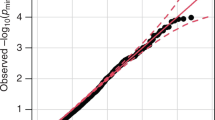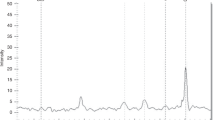Abstract
Deficiency in the collectin mannose-binding lectin (MBL) increases the risk for pulmonary and systemic infections and its complications in children and adults. The aim of this prospective cohort study was to determine the genetic association of sequence variations within the MBL gene with systemic infections and pulmonary short- and long-term complications in preterm infants below 32 weeks gestational age (GA). Three single-nucleotide polymorphisms (SNPs) in the coding region and one SNP in the promotor region of MBL2 were genotyped by direct sequencing and with sequence-specific probes in 284 newborn infants <32 weeks GA. Clinical variables were comprehensively monitored. An association was found between two SNPs and the development of bronchopulmonary dysplasia (BPD), defined as persistent oxygen requirement at 36 weeks postmenstrual age, adjusting for covariates GA, grade of respiratory distress syndrome and days on mechanical ventilation (rs1800450 (exon 1 at codon 54, B variant): odds ratio dominant model (OR)=3.59, 95% confidence interval (CI)=1.62–7.98; rs7096206 (−221, X variant): OR=2.40, 95% CI=1.16–4.96). Haplotype analyses confirmed the association to BPD, and a single haplotype (frequency 56%) including all SNPs in their wild-type form showed a negative association with the development of BPD. We detected no association between the MBL gene variations and the development of early-onset infections or further pulmonary complications. Frequent variants of the MBL gene, leading to low MBL concentrations, are associated with the diagnosis of BPD in preterm infants. This provides a basis for potential therapeutic options and further genetic and proteomic analysis of the function of MBL in the resistance against pulmonary long-term complications in preterm infants.
This is a preview of subscription content, access via your institution
Access options
Subscribe to this journal
Receive 6 digital issues and online access to articles
$119.00 per year
only $19.83 per issue
Buy this article
- Purchase on Springer Link
- Instant access to full article PDF
Prices may be subject to local taxes which are calculated during checkout
Similar content being viewed by others
References
Turner MW . Mannose-binding lectin: the pluripotent molecule of the innate immune system. Immunol Today 1996; 17: 532–540.
Holmskov U, Thiel S, Jensenius JC . Collectins and ficollins: humoral lectins of the innate immune defense. Annu Rev Immunol 2003; 21: 547–578.
Madsen HO, Garred P, Thiel S, Kurtzhals JA, Lamm LU, Ryder LP et al. Interplay between promoter and structural gene variants control basal serum level of mannan-binding protein. J Immunol 1995; 155: 3013–3020.
Turner MW, Hamvas RM . Mannose-binding lectin: structure, function, genetics and disease associations. Rev Immunogenet 2000; 2: 305–322.
Sumiya M, Super M, Tabona P, Levinsky RJ, Arai T, Turner MW et al. Molecular basis of opsonic defect in immunodeficient children. Lancet 1991; 337: 1569–1570.
Wallis R, Drickamer K . Molecular determinants of oligomer formation and complement fixation in mannose-binding proteins. J Biol Chem 1999; 274: 3580–3589.
Garred P, Larsen F, Madsen HO, Koch C . Mannose-binding lectin deficiency—revisited. Mol Immunol 2003; 40: 73–84.
Madsen HO, Garred P, Kurtzhals JA, Lamm LU, Ryder LP, Thiel S et al. A new frequent allele is the missing link in the structural polymorphism of the human mannan-binding protein. Immunogenetics 1994; 40: 37–44.
Madsen HO, Satz ML, Hogh B, Svejgaard A, Garred P . Different molecular events result in low protein levels of mannan-binding lectin in populations from southeast Africa and South America. J Immunol 1998; 161: 3169–3175.
Garred P, Madsen HO . Genetic susceptibility to sepsis: a possible role for mannose-binding lectin. Curr Infect Dis Rep 2004; 6: 367–373.
Koch A, Melbye M, Sorensen P, Homoe P, Madsen HO, Molbak K et al. Acute respiratory tract infections and mannose-binding lectin insufficiency during early childhood. J Am Med Assoc 2001; 285: 1316–1321.
Neth O, Hann I, Turner MW, Klein NJ . Deficiency of mannose-binding lectin and burden of infection in children with malignancy: a prospective study. Lancet 2001; 358: 614–618.
Hibberd ML, Sumiya M, Summerfield JA, Booy R, Levin M . Association of variants of the gene for mannose-binding lectin with susceptibility to meningococcal disease. Meningococcal Research Group. Lancet 1999; 353: 1049–1053.
Summerfield JA, Sumiya M, Levin M, Turner MW . Association of mutations in mannose binding protein gene with childhood infection in consecutive hospital series. BMJ 1997; 314: 1229–1232.
Dean MM, Minchinton RM, Heatley S, Eisen DP . Mannose binding lectin acute phase activity in patients with severe infection. J Clin Immunol 2005; 25: 346–352.
Eisen DP, Dean MM, Thomas P, Marshall P, Gerns N, Heatley S et al. Low mannose-binding lectin function is associated with sepsis in adult patients. FEMS Immunol Med Microbiol 2006; 48: 274–282.
Adams-Chapman I, Stoll BJ . Neonatal infection and long-term neurodevelopmental outcome in the preterm infant. Curr Opin Infect Dis 2006; 19: 290–297.
Jobe AH, Ikegami M . Antenatal infection/inflammation and postnatal lung maturation and injury. Respir Res 2001; 2: 27–32.
Stoll BJ, Hansen NI, Adams-Chapman I, Fanaroff AA, Hintz SR, Vohr B et al. Neurodevelopmental and growth impairment among extremely low-birth-weight infants with neonatal infection. J Am Med Assoc 2004; 292: 2357–2365.
Ogihara T, Okamoto R, Kim HS, Nagai A, Morinobu T, Moji H et al. New evidence for the involvement of oxygen radicals in triggering neonatal chronic lung disease. Pediatr Res 1996; 39: 117–119.
Speer CP . Pre- and postnatal inflammatory mechanisms in chronic lung disease of preterm infants. Paediatr Respir Rev 2004; 5 (Suppl A): S241–S244.
Carlton DP, Albertine KH, Cho SC, Lont M, Bland RD . Role of neutrophils in lung vascular injury and edema after premature birth in lambs. J Appl Physiol 1997; 83: 1307–1317.
Jobe AH, Bancalari E . Bronchopulmonary dysplasia. Am J Respir Crit Care Med 2001; 163: 1723–1729.
Groneck P, Gotze-Speer B, Oppermann M, Eiffert H, Speer CP . Association of pulmonary inflammation and increased microvascular permeability during the development of bronchopulmonary dysplasia: a sequential analysis of inflammatory mediators in respiratory fluids of high-risk preterm neonates. Pediatrics 1994; 93: 712–718.
Kotecha S, Chan B, Azam N, Silverman M, Shaw RJ . Increase in interleukin-8 and soluble intercellular adhesion molecule-1 in bronchoalveolar lavage fluid from premature infants who develop chronic lung disease. Arch Dis Child Fetal Neonatal Ed 1995; 72: F90–F96.
Kotecha S, Wilson L, Wangoo A, Silverman M, Shaw RJ . Increase in interleukin (IL)-1 beta and IL-6 in bronchoalveolar lavage fluid obtained from infants with chronic lung disease of prematurity. Pediatr Res 1996; 40: 250–256.
Ueda K, Cho K, Matsuda T, Okajima S, Uchida M, Kobayashi Y et al. A rat model for arrest of alveolarization induced by antenatal endotoxin administration. Pediatr Res 2006; 59: 396–400.
Kielgast S, Thiel S, Henriksen TB, Bjerke T, Olsen J, Jensenius JC . Umbilical cord mannan-binding lectin and infections in early childhood. Scand J Immunol 2003; 57: 167–172.
Benedetti de F, Auriti C, D'Urbano LE, Ronchetti MP, Rava L, Tozzi A et al. Low serum levels of mannose binding lectin are a risk factor for neonatal sepsis. Pediatr Res 2007; 61: 325–328.
LeVine AM, Whitsett JA, Gwozdz JA, Richardson TR, Fisher JH, Burhans MS et al. Distinct effects of surfactant protein A or D deficiency during bacterial infection on the lung. J Immunol 2000; 165: 3934–3940.
Crouch E, Hartshorn K, Ofek I . Collectins and pulmonary innate immunity. Immunol Rev 2000; 173: 52–65.
Gordon AC, Waheed U, Hansen TK, Hitman GA, Garrard CS, Turner MW et al. Mannose-binding lectin polymorphisms in severe sepsis: relationship to levels, incidence, and outcome. Shock 2006; 25: 88–93.
Abman SH, Groothius JR . Pathophysiology and treatment of bronchopulmonary dysplasia. Current issues. Pediatr Clin North Am 1994; 41: 277–315.
Hitti J, Krohn MA, Patton DL, Tarczy-Hornoch P, Hillier SL, Cassen EM et al. Amniotic fluid tumor necrosis factor-alpha and the risk of respiratory distress syndrome among preterm infants. Am J Obstet Gynecol 1997; 177: 50–56.
Kim BI, Lee HE, Choi CW, Jo HS, Choi EH, Koh YY et al. Increase in cord blood soluble E-selectin and tracheal aspirate neutrophils at birth and the development of new bronchopulmonary dysplasia. J Perinat Med 2004; 32: 282–287.
Yoon BH, Romero R, Jun JK, Park KH, Park JD, Ghezzi F et al. Amniotic fluid cytokines (interleukin-6, tumor necrosis factor-alpha, interleukin-1 beta, and interleukin-8) and the risk for the development of bronchopulmonary dysplasia. Am J Obstet Gynecol 1997; 177: 825–830.
Zimmerman JJ . Bronchoalveolar inflammatory pathophysiology of bronchopulmonary dysplasia. Clin Perinatol 1995; 22: 429–456.
Gibson CS, MacLennan AH, Goldwater PN, Haan EA, Priest K, Dekker GA . The association between inherited cytokine polymorphisms and cerebral palsy. Am J Obstet Gynecol 2006; 194:674. e1–e11.
Bhandar V, Choo-Wing R, Lee CG, Zhu Z, Nedrelow JH, Chupp GL et al. Hyperoxia causes angiopoietin 2-mediated acute lung injury and necrotic cell death. Nat Med 2006; 12: 1286–1293.
Alejandre-Alcazar MA, Kwapiszewska G, Reiss I, Amarie OV, Marsh LM, Sevilla-Perez J et al. Hyperoxia modulates TGF-beta/BMP signaling in a mouse model of bronchopulmonary dysplasia. Am J Physiol Lung Cell Mol Physiol 2007; 292: L537–L549.
Ambalavanan N, Novak ZE . Peptide growth factors in tracheal aspirates of mechanically ventilated preterm neonates. Pediatr Res 2003; 53: 240–244.
Nauta AJ, Raaschou-Jensen N, Roos A, Daha MR, Madsen HO, Borrias-Essers MC et al. Mannose-binding lectin engagement with late apoptotic and necrotic cells. Eur J Immunol 2003; 33: 2853–2863.
Wright JR . Host defense functions of pulmonary surfactant. Biol Neonate 2004; 85: 326–332.
Rova M, Haataja R, Marttila R, Ollikainen V, Tammela O, Hallman M . Data mining and multiparameter analysis of lung surfactant protein genes in bronchopulmonary dysplasia. Hum Mol Genet 2004; 13: 1095–1104.
Franz AR, Steinbach G, Kron M, Pohlandt F . Interleukin-8: a valuable tool to restrict antibiotic therapy in newborn infants. Acta Paediatr 2001; 90: 1025–1032.
Mathers NJ, Pohlandt F . Diagnostic audit of C-reactive protein in neonatal infection. Eur J Pediatr 1987; 146: 147–151.
Rodwell RL, Taylor KM, Tudehope DI, Gray PH . Hematologic scoring system in early diagnosis of sepsis in neutropenic newborns. Pediatr Infect Dis J 1993; 12: 372–376.
Sherman MP, Goetzman BW, Ahlfors CE, Wennberg RP . Tracheal aspiration and its clinical correlates in the diagnosis of congenital pneumonia. Pediatrics 1980; 65: 258–263.
Stoll BJ, Gordon T, Korones SB, Shankaran S, Tyson JE, Bauer CR et al. Early-onset sepsis in very low birth weight neonates: a report from the National Institute of Child Health and Human Development Neonatal Research Network. J Pediatr 1996; 129: 72–80.
Couchard M, Polge J, Bomsel F . Maladie des membranes hyalines. Diagnostic et surveillance radiologiques. Traitement, complications. Etude radioclinique de 589 cas. Ann Radiol 1974; 17: 669–683.
Wellek S . Tests for establishing compatibility of an observed genotype distribution with Hardy–Weinberg equilibrium in the case of a biallelic locus. Biometrics 2004; 60: 694–703.
Simes RJ . An improved Bonferroni procedure for multiple tests of significance. Biometrika 1986; 73: 751–754.
Ziegler A, König IR . A Statistical Approach to Genetic Epidemiology. Concepts and Applications. Wiley-VCH: Weinheim, 2006.
Schaid DJ . Relative efficiency of ambiguous vs directly measured haplotype frequencies. Genet Epidemiol 2002; 23: 426–443.
Acknowledgements
We thank Mrs Gabriela Haley and Mrs Uta Schellenberg for excellent technical assistance. This work was supported by grants from the Bundesministerium fuer Bildung und Forschung, Germany, national genome research network (NGFN NIE-S14T04, 01GR0466, PGE-S26T11). The experiments performed comply with the current laws of Germany.
Author information
Authors and Affiliations
Corresponding author
Rights and permissions
About this article
Cite this article
Hilgendorff, A., Heidinger, K., Pfeiffer, A. et al. Association of polymorphisms in the mannose-binding lectin gene and pulmonary morbidity in preterm infants. Genes Immun 8, 671–677 (2007). https://doi.org/10.1038/sj.gene.6364432
Received:
Revised:
Accepted:
Published:
Issue Date:
DOI: https://doi.org/10.1038/sj.gene.6364432
Keywords
This article is cited by
-
Bronchopulmonary dysplasia and wnt pathway-associated single nucleotide polymorphisms
Pediatric Research (2022)
-
Verification of immunology-related genetic associations in BPD supports ABCA3 and five other genes
Pediatric Research (2022)
-
Association between innate immunity gene polymorphisms and neonatal sepsis development: a systematic review and meta-analysis
World Journal of Pediatrics (2022)
-
Serum mannose-binding lectin (MBL) gene polymorphism and low MBL levels are associated with neonatal sepsis and pneumonia
Journal of Perinatology (2012)
-
Genetic associations of surfactant protein D and angiotensin-converting enzyme with lung disease in preterm neonates
Journal of Perinatology (2012)



